![]()
![]()
![]()
Use LEFT and RIGHT arrow keys to navigate between flashcards;
Use UP and DOWN arrow keys to flip the card;
H to show hint;
A reads text to speech;
48 Cards in this Set
- Front
- Back
|
Functions of the reticular formation:
|
- maintenance of a conscious state
- sleep & wake cycles - respiration - cardiac control - coordination of brainstem reflexes (chewing, swallowing, etc) *contains collaterals, provide |
|
|
Interneurons near cranial nerve motor nuclei lie in the reticular formation. What neurons are they contacted by?
|
corticobulbar neurons
(corticobulbar projections end in ret form adjacent to actual CN nuclei) |
|
|
List the primary reticular formatiion nuclei:
|

Precerebellar nucli
Raphe nuclei The Central Nuclear Group The Lateral Parvocellular zone Respiratory control areas Cardiovascular Control Areas Neurotransmitter Groupings Functional Centers |
|
|
______________ nuclei receive highly integrated sensory info & cortical input & project to the cerebellum
|
precerebellar nuclei
(medullary paramedian reticular (from spinal cord, reticulotegmental (afferents from cortex) & lateral reticular nucleus (from Clarke's column) |
|
|
The _________ nucleus is a precerebellar nucleus that receives & integrates sensory motor feedback data from the spinal cord & projects to the cerebellum.
|
lateral reticular nucleus
|
|
|
________ nuclei lie near the midline of the brainstem, from the medulla--> brainstem, & use serotonin as their primary neurotransmitter
|
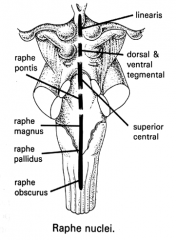
raphe nuclei
(modulate sensory input, consciousness) |
|
|
Raphe nuclei give rise to ascending (rostral) or descending (caudal) projections?
|
BOTH
(both motor & sensory also) |
|
|
__________ nuclei sends descending (caudal) projections to the brainstem & spinal cord nuclei. Fxns relate to regulation of sensory info (some motor affect also)
|
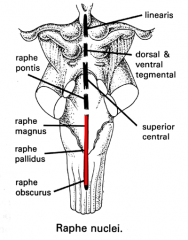
medullary raphe nuclei
(motor activity modulated by nucleus raphe pallidus & nucleus raphe obscuris)** |
|
|
Nucleus__________ projects to spinal cord dorsal horn & makes connections w/ opiate containing neurons (enkephalin) in the _______________
Stimulation of these pathways can produce what? |
nucleus raphe magnus (one of the medullary raphe nuclei)
periaqueductal gray produce analgesia w/ little effect on tactile stimuli= pain INHIBITION |
|
|
Opiate antagonists can block what?
|
the stimulation induced analgesia
|
|
|
_________ nucleus also projects via (dorsal longitudinal fasciculus) DLF to brainstem preganglionic autonomic neurons and can influence autonomic activity (excitatory or inhibitor)
|
nucleus raphe magnus
|
|
|
Where do the rostrally projecting raphe nuclei receive inputs from?
Where do they send ascending projections? |
a variety of forebrain & brainstem sources
to wide regions of cerebral cortex (via median forebrain bundle)--> serotinergic prokections |
|
|
What processes to the rostrally projecting raphe nuclei affect?
|
sleep
aggressive behavior neuroendocrine functions |
|
|
The __________ influence appears to be a source of drug actions on cognitive processes (SSRIs)
|
serotinergic
|
|
|
The __________ contains a broad range of nuclei over entire brainstem, w/ regions related to both motor & sensory & to general activation of cortex & brainstem
|

the central nuclear group
|
|
|
major motor nuclei are the origin of the pontine & medullary ____________ tracts
|
reticulospinal tracts
(reticular arousal system & some eye movement also in central nuclear group) |
|
|
_____________ tract is formed by neurons in pons & descends primarily ipsilaterally. It has powerful EXCITATORY influences on spinal motor neurons.
|
The Pontine (medial) reticulospinal tract
|
|
|
The Pontine (medial) reticulospinal tract is (flexor/extensor) biased
|
EXTENSOR biased
*largely to proximal limb musculature (posture) |
|
|
____________ tract is formed in the medulla & descends bilaterally to the spinal cord. It has a strong INHIBITORY influence on spinal motor neurons
|
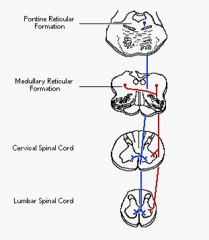
The medullary (lateral) Reticulospinal tract
|
|
|
The medullary reticulospinal tract has reflex activities that are (flexor/extensor) biased
|

EXTENSOR biased
*may mediate generalized muscular atonia during REM sleep (inhibits extensors--> stiff back--> relax) |
|
|
__________ formation is part of the central nuclear group (along w/ accessory oculomotor nuclei) & is associated w/ horizontal & vertical eye movements
|
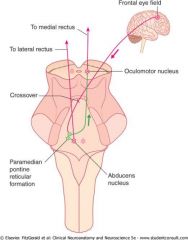
paramedian postine reticular formation (PPRF)
|
|
|
T/F
The central nuclear group also has sensory receiving areas |
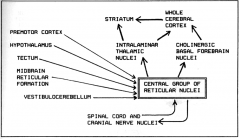
TRUE
(receives sensory collaterals from a broad range of sources) |
|
|
The sensory areas of the central nuclear group project rostrally via _____________
|
the CTT to the thalamus (intralaminar nuclei) & to the zona incerta
|
|
|
Where do the sensory receiving nuclei (central group) of the basal forebrain project?
What do they form? |
cerebral cortex
form the ascending reticular arousal system (ARAS) |
|
|
What do the sensory receiving nuclei of the basal forebrain do?
|
maintain conscious state, desynchronize the EEG for behavior arousal, & activate the EEG for REM sleep
|
|
|
_________________ area contains sensory nuclei that regulate specific & nonspecific functions of LOCAL brainstem processing
|
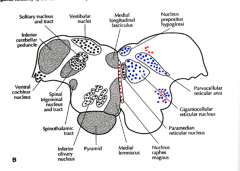
The lateral parvocellular area
|
|
|
__________________ nucleus receives sensory info from trigeminal, auditory system, & cortex & projects to cranial motor nuclei associated w/ chewing & swallowing
|

nucleus reticularis parvocellularis (part of lateral parvocellular area)
=chewing & swallowing correlative center* |
|
|
The ______________ contains nuclei that regulate respiration, cardiac cycle & BP
|
medullary parvocellar area
|
|
|
The _______ nuclei extend from the medulla to the dorsolateral pons and include the parabrachial complex and Killiker-Fuse nuclei.
|
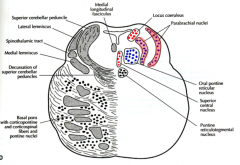
respiratory nuclei (of medullary parvocellular area)
|
|
|
The parabrachial complex (medullary parvocellular) receives a broad variety of ascending visceral info but its most important function is what?
|
regulating respiratory rhythm
|
|
|
What are the other primary nuclear groups that regulate respiration?
|
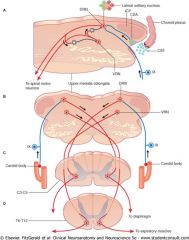
superficial medullary neuronal group
dorsal respiratory group ventral respiratory group |
|
|
_______________ group near CN 8 & 9 has receptors for O2, CO2 and H+ for CSF.
(regulates respiration via chemoreceptors) |
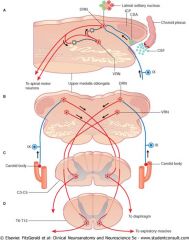
The superficial medullary neuronal group
|
|
|
The _____________ group (lat. region of solitary nuc) integrates respiratory sensory info from superficial medullary neuronal group, carotid & aortic bodies, & vagus (stretch receptors).
What is its influence on the phrenic nucleus? |
the dorsal respiratory group (‘Inspiratory area”) (DRN)
has contralateral "inspiratory" influence on phrenic nucleus |
|
|
The _______ group projects from C1 to the caudal pons. It is excitatory to phrenic and throacolumbar motor neurons associated with respiration (via DRN).
How does it differ from DRN? |
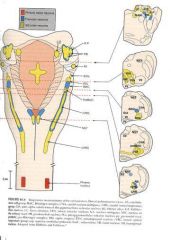
ventral respiratory group (VRN)
mostly expiratory instead of inspiratory |
|
|
The _____________ are part of the ventral respiratory group that inhibit respiratory motor neurons.
A sub part of this group the __________ nuclei appears to generate the respiratory rhythm. |
Botzinger complex of nuclei
(prevents inspiration/exhalation at same time pre-Botzinger nuclei = generate resp rhythm (all others regulate, not generate) |
|
|
The ______________ nuceli (part of prebrachial complex) is the "pneumotaxic center", a primary respiratory regulator
|
Kolliker-Fuse nuclei
(regulates NOT generate) |
|
|
Central respiratory influences from higher autonomic control centers is via ____________nuclei
Local respiratory reflexes from carotid & aortic bodes (CO2 levels) is via ___________________ |
DRN, VRN, parabrachial complex (Botzinger, Kolliker-fuse) nuclei
superficial medullary neuronal groups |
|
|
The superficialy medullary area also provides sensory input for cardiovascular influences in the medulla
This input is integrated by the _____________ nucleus at the level of CN IX and X. |

medial solitary nucleus
|
|
|
The medial solitary nucleus receives information from the superficial medullary group and receives stretch receptor information from the __________.
|
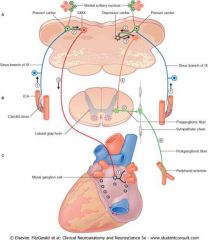
carotid sinus
|
|
|
Where does the medial solitary nucleus send information?
What do these projections stimulate ? |
to the vagal motor nucleus (parasympathetic)
cardiovascular response--> decreases HR & increases BP |
|
|
The central nuclear group also contributes to cardiovascular response via projects to ______________
What do these projections stimulate? |
project to the intermediolateral cell column of the spinal cord
peripheral vasodilation (sympathetic |
|
|
What do the catecholaminergic group of the reticular formation contain?
|
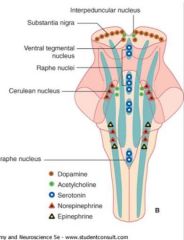
norepi, epi, and/or dopamine
(designates as A1, C1, A2-A11) |
|
|
The ________is the major rostrally projecting catecholaminergic nucleus and supplies much of the forebrain.
It plays an important role in what? |
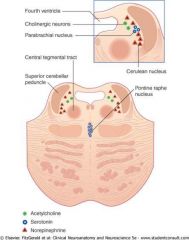
locus coeruleus (A6)
sleep mechanisms (motor activity) |
|
|
The ________________ is the most prominent cholinergic nuclei of the brainstem, it appears to generate locomotor patterns (walking)
|
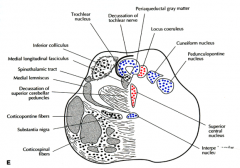
pedunculopontine nucleus
(fxns via Ach) |
|
|
The area postrema (chemical trigger zone, area for emesis) is located in the _______ ventricle near the ___________
|
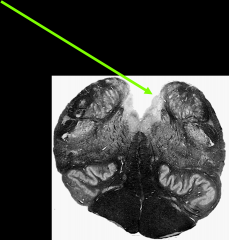
4th ventricle
vagal triangle |
|
|
The area postrema has no ___________
|
BBB
|
|
|
The area prostrem forms the afferent limb of the __________ reflex & is sensitive to emetic drugs.
|
vomiting reflex
|
|
|
The reticular formation is the source of 2 primary spinal cord tracts. What are they?
|
1. lateral Reticulospinal tract
2. medial reticulospinal tract |

